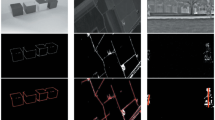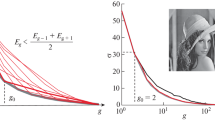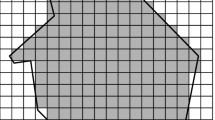Abstract
The problem of edge detection is viewed as a hierarchy of detection problems where the geometric objects to be detected (e.g., edge points, curves, regions) have increasing complexity and spatial extent. An early stage of the proposed hierarchy consists in detecting the regular portions of the visible edges. The input to this stage is given by a graph whose vertices are tangent vectors representing local and uncertain information about the edges. A model relating the input vector graph to the curves to be detected is proposed. An algorithm with linear time complexity is described which solves the corresponding detection problem in a worst-case scenario. The stability of curve reconstruction in the presence of uncertain information and multiple responses to the same edge is analyzed and addressed explicitly by the proposed algorithm.
Similar content being viewed by others
Explore related subjects
Discover the latest articles, news and stories from top researchers in related subjects.References
Bienenstock, E. and Geman, S. 1995. Compositionality in neural systems. In The Handbook of Brain Theory and Neural Networks, M.A. Arbib (Ed.), MIT Press.
Canny, J. 1986. A computational approach to edge detection. IEEE Transactions on Pattern Analysis and Machine Intelligence, 8:679-698.
Casadei, S. 1995. Model based detection of curves in images. Technical Report LIDS-TH-2306, Laboratory for Information and Decision Systems, Massachusetts Institute of Technology.
Casadei, S. and Mitter, S.K. 1996a. A hierarchical approach to high resolution edge contour reconstruction. In Proc. of the IEEE Conf. on Computer Vision and Pattern Recognition.
Casadei, S. and Mitter, S.K. 1996b. Hierarchical curve reconstruction. Part 1: Bifurcation analysis and recovery of smooth curves. In Proc. of the Fourth European Conf. on Computer Vision.
Caselles, V., Kimmel, R., and Sapiro, G. 1995. Geodesic active contours. In Proc. of the Int. Conf. of Computer Vision, pp. 694-699.
Cohen, L. and Kimmel, R. 1996. Global minimum for active contour models: A minimum path approach. In Proc. of the IEEE Conf. on Computer Vision and Pattern Recognition, pp. 666-673.
David, C. and Zucker, S. 1990. Potentials, valleys, and dynamic global coverings. International Journal of Computer Vision, 5(3):219-238.
Deriche, R. and Blaszka, T. 1993. Recovering and characterizing image features using an efficient model based approach. In Proc. of the IEEE Conf. on Computer Vision and Pattern Recognition.
Dolan, J. and Riseman, E. 1992. Computing curvilinear structure by token-based grouping. In Proc. of the IEEE Conf. on Computer Vision and Pattern Recognition.
Elder, J. and Zucker, S. 1996a. Local scale control for edge detection and blur estimation. In Proc. of the Fourth European Conf. on Computer Vision, pp. II:57-69.
Elder, J.H. and Zucker, S.W. 1996b. Computing contour closure. In Proc. of the Fourth European Conf. on Computer Vision, pp. 399- 411.
Geiger, D. and Kumaran, K. 1996. Visual organization of illusory surfaces. In Proc. of the Fourth European Conf. on Computer Vision, pp. I:413-424.
Geiger, D., Kumaran, K., and Parida, L. 1996. Visual organization for figure/ground separation. In Proc. of the IEEE Conf. on Computer Vision and Pattern Recognition, pp. 155-160.
Geman, S. and Geman, D. 1984. Stochastic relaxation, gibbs distributions, and the bayesian restoration of images. IEEE Transactions on Pattern Analysis and Machine Intelligence, 6:721-741.
Hancock, E. and Kittler, J. 1990. Edge-labeling using dictionarybased relaxation. IEEE Transactions on Pattern Analysis and Machine Intelligence, 12:165-181.
Haralick, R. 1984. Digital step edges from zero crossing of second directional derivatives. IEEE Transactions onPattern Analysis and Machine Intelligence, 6:58-68.
Iverson, L. and Zucker, S. 1995. Logical/linear operators for image curves. IEEE Transactions on Pattern Analysis and Machine Intelligence, 17(10):982-996.
Kanizsa, G. 1979. Organization in Vision: Essays on Gestalt Perception. Praeger: NY.
Kass, M., Witkin, A., and Terzopoulos, D. 1988. Snakes: Active contour models. International Journal of Computer Vision, 1:321- 331.
Kichenassamy, S., Kumar, A., Olver, P., Tannenbaum, A., and Yezzi, A. 1995. Gradient flows and geometric active contour models. In Proc. of the Int. Conf. of Computer Vision, pp. 810-815.
Lowe, D. 1985. Perceptual Organization and Visual Recognition. Kluwer.
Marroquin, J., Mitter, S.K., and Poggio, T. 1987. Probabilistic solution of ill-posed problems in computational vision. Journal of American Statistical Ass., 82(397):76-89.
Mohan, R. and Nevatia, R. 1992. Perceptual organization for scene segmentation and description. IEEE Transactions on Pattern Analysis and Machine Intelligence, 14.
Mumford, D. and Shah, J. 1989. Optimal approximations of piecewise smooth functions and associated variational problems. Comm. in Pure and Appl. Math., 42:577-685.
Nayar, S., Baker, S., and Murase, H. 1996. Parametric feature detection. In Proc. of the IEEE Conf. on Computer Vision and Pattern Recognition, pp. 471-477.
Nitzberg, M. and Mumford, D. 1990. The 2.1-d sketch. In Proc. of the Third Int. Conf. of Computer Vision, pp. 138-144.
Nitzberg, M., Mumford, D., and Shiota, T. 1993. Filtering, segmentation, and depth, vol. 662 of Lecture Notes in Computer Science. Springer-Verlag.
Parent, P. and Zucker, S. 1989. Trace inference, curvature consistency, and curve detection. IEEE Transactions on Pattern Analysis and Machine Intelligence, 11.
Perona, P. 1992. Steerable-scalable kernels for edge detection and junction analysis. In Proc. of the Second European Conf. on Computer Vision, pp. 3-18.
Perona, P. and Malik, J. 1990. Detecting and localizing edges composed of steps, peaks and roofs. In Proc. of the Third Int. Conf. of Computer Vision, Osaka, pp. 52-57.
Richardson, T.J. and Mitter, S.K. 1994. Approximation, computation, and distorsion in the variational formulation. In Geometry-Driven Diffusion in Computer Vision. B. Ter Haar Romeny (Ed.), Kluwer.
Rohr, K. 1992. Recognizing corners by fitting parametric models. International Journal of Computer Vision, 9(3).
Rosenthaler, L., Heitger, F., Kubler, O., and von der Heydt, R. 1992. Detection of general edges and keypoints. In Proc. of the Second European Conf. on Computer Vision.
Sarkar, S. and Boyer, K. 1993. Perceptual organization in computer vision: Areviewand a proposal for a classificatory structure. IEEE Trans. Systems, Man, and Cybernetics, 23:382-399.
Sha'ashua, A. and Ullman, S. 1988. Structural saliency: The detection of globally salient structures using a locally connected network. In Proc. of the Second Int. Conf. of Computer Vision, pp. 321-327.
Shah, J. 1996. A common framework for curve evolution, segmentation and anisotropic diffusion. In Proc. of the IEEE Conf. on Computer Vision and Pattern Recognition, pp. 136- 142.
Subirana-Vilanova, J.B. and Sung, K.K. 1992. Perceptual organization without edges. In Image Understanding Workshop.
Williams, L. and Jacobs, D. 1995. Stochastic completion fields: A neural model of illusory contour shape and salience. In Proc. of the Int. Conf. of Computer Vision, pp. 408-415.
Zhu, S., Lee, T., and Yuille, A. 1995. Region competition: Unifying snakes, region growing, and bayes/mdl for multi-band image segmentation. Technical Report CICS-P-454, Center for Intelligent Control Systems.
Zucker, S.W., David, C., Dobbins, A., and Iverson, L. 1988. The organization of curve detection: Coarse tangent fields and fine spline coverings. In Proc. of the Second Int. Conf. of Computer Vision.
Author information
Authors and Affiliations
Rights and permissions
About this article
Cite this article
Casadei, S., Mitter, S. Hierarchical Image Segmentation—Part I: Detection of Regular Curves in a Vector Graph. International Journal of Computer Vision 27, 71–100 (1998). https://doi.org/10.1023/A:1007905813513
Issue Date:
DOI: https://doi.org/10.1023/A:1007905813513




